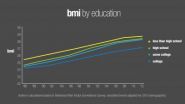(Press-News.org) CHAMPAIGN, Ill. — Everything you think you know about the causes of rising obesity in the U.S. might be wrong, researchers say in a new report.
Contrary to popular belief, people are exercising more today, have more leisure time and better access to fresh, affordable food – including fruits and vegetables – than they did in past decades. And while troubling disparities exist among various groups, most economic, educational, and racial or ethnic groups have seen their obesity levels rise at similar rates since the mid-1980s, the researchers report.
The new analysis appears in CA: Cancer Journal for Clinicians.
Obesity rates in the U.S. have been going up for decades, said University of Illinois kinesiology and community health professor Ruopeng An, who conducted the new analysis with Roland Sturm, of the RAND Corp. in Santa Monica, California.
"Many factors have been suggested as causes," the researchers wrote. Snack food, fast food, automobile use, time spent viewing television or looking at computer screens, the ubiquity of vending machines, suburban sprawl, increasing portion sizes, female labor force participation, poverty, affluence, supermarket availability and even the absence of supermarkets are blamed, the researchers said.
"As it turns out, some widely held beliefs about societal trends are unambiguously false; others require some qualifications," they wrote.
Geography and the existence of so-called "food deserts" (neighborhoods or regions with limited access to affordable, healthy food) appear to have little bearing on the obesity trend in general, although they may be linked to differences between groups at any given point in time, An said.
"A common misbelief is that the obesity epidemic reflects increasing social disparities and that the largest weight gains are concentrated in groups identifiable by race, ethnicity, income, education or geography," he said. "And it's true that if you look at the national data for any one point in time, it's not hard to figure out, for example, that the people with the lowest education tend to have the highest obesity rate. Everyone buys this argument. But what is less obvious is how surprisingly similar the obesity trend is for all groups."
A look at graphs of obesity over time (see The Obesity Trend) offers a more universal view of what is going on, An said. Obesity is higher for blacks than for whites, but both groups are getting heavier at almost the same rate over time. The same disparity is seen in people who never finished high school versus those with a college degree, or those with lower versus higher incomes. The trend lines vary somewhat – the gap between white men and black men has recently narrowed, for example, while the gap for black and white women has widened – but obesity is going up in all these groups at about the same rate, An said.
"The gap between groups is secondary to the increase that all groups experience over time," he said. "So a reversal of the obesity epidemic would need universal intuitions rather than a focus on certain groups."
Some common explanations for the upward surge in obesity are simply wrong, An said. For example, the idea that longer workdays or less leisure time are to blame is not supported by the data. Americans are working fewer hours and have more leisure time than they did in the 1960s, he said. People are spending less time on household chores and caring for dependents than they did decades ago, and they have more free time than ever, he said.
The notion that people are getting fatter because they have less access to affordable, healthy foods also contradicts the data, An said.
"The percent of disposable income spent on food fell quite a bit from 1970 to 2010," he said. "And in fact in the 1930s American people spent one-third of their disposable income on food, while today people spend less than one-tenth. So it's hard to argue that food has become more expensive in general."
The cost of fruits and vegetables has not increased over time, as some have argued, but has gone down more than 20 percent since 1970, the researchers report.
"The price of fruits and vegetables is decreasing – but not as rapidly as the cost of junk food," An said.
Overall, food is more accessible and affordable than ever in the United States, and this may be an important factor in the dramatic rise in obesity, he said.
The data on exercise and physical activity also are muddier than some people like to admit, An said. American participants in the Behavioral Risk Factor Survey reported in 2012 that they were exercising on average four minutes more a day than reported in 2003. But they also reported sleeping 10 minutes longer and watching 15 more minutes of TV.
"Self-reported exercise increases over time, and the total sedentary time also increases over time," An said. "So we are kind of in a dilemma trying to figure out what really contributes to the obesity epidemic. We have a lot of hypotheses but we really don't have much data to support them at this stage."
INFORMATION:
Editor's notes: To reach Ruopeng An, call 217-244-0966; email ran5@illinois.edu.
The paper, "Obesity and Economic Environments," is available online or
from the U. of I. News Bureau.
Intuitions about the causes of rising obesity are often wrong, researchers report
2014-05-22
ELSE PRESS RELEASES FROM THIS DATE:
Review says inexpensive food a key factor in rising obesity
2014-05-22
ATLANTA May 22, 2014—A new review summarizes what is known about economic factors tied to the obesity epidemic in the United States and concludes many common beliefs are wrong. The review, authored by Roland Sturm, PhD of RAND Corporation and Ruopeng An, PhD, of the University of Illinois at Urbana-Champaign, notes that paradoxically, rising obesity rates coincided with increases in leisure time, increased fruit and vegetable availability, and increased exercise uptake. The review appears early online in CA: A Cancer Journal for Clinicians and finds at least one factor ...
Scientists find new way to combat drug resistance in skin cancer
2014-05-22
RAPID RESISTANCE to vemurafenib – a treatment for a type of advanced melanoma, the deadliest form of skin cancer – could be prevented by blocking a druggable family of proteins, according to research* published in Nature Communications today (Thursday).
Scientists at the Cancer Research UK Manchester Institute, based at the University of Manchester, have revealed the MLK family of four enzymes 'undoes' the tumour-shrinking effects of vemurafenib**.
Around half of metastatic melanomas – aggressive skin cancer that has spread to other parts of the body – are caused by ...
Canada funds 65 innovative health projects to help save every woman, every child
2014-05-22
Grand Challenges Canada, funded by the Government of Canada, today announces investments of $12 million in projects worldwide, aimed squarely at improving the health and saving the lives of mothers, newborns and children in developing countries.
From a "lucky iron fish" placed in tens of thousands of Asian cooking pots to reduce anemia, to "motherhood insurance" to ensure that poverty doesn't impede emergency care if needed during a baby's delivery, to kits for home farming edible insects to improve nutrition in slums of Africa and Latin America, the 65 imaginative projects ...
New insights into premature ejaculation could lead to better diagnosis and treatment
2014-05-22
There are many misconceptions and unknowns about premature ejaculation in the medical community and the general population. Two papers, both being published simultaneously in Sexual Medicine and the Journal of Sexual Medicine, provide much-needed answers that could lead to improved diagnosis and treatment for affected men.
Premature ejaculation can cause significant personal and interpersonal distress to a man and his partner. While it has been recognized as a syndrome for well over 100 years, the clinical definition of premature ejaculation has been vague, ambiguous, ...
Could cannabis curb seizures? Experts weed through the evidence
2014-05-22
The therapeutic potential of medical marijuana and pure cannabidiol (CBD), an active substance in the cannabis plant, for neurologic conditions is highly debated. A series of articles published in Epilepsia, a journal of the International League Against Epilepsy (ILAE), examine the potential use of medical marijuana and CBD in treating severe forms of epilepsy such as Dravet syndrome.
In a case study, Dr. Edward Maa, Chief of the Comprehensive Epilepsy Program at Denver Health in Denver, Colo., details one mother's experience of providing medical marijuana to her child ...
Scientists announce top 10 new species for 2014
2014-05-22
SYRACUSE, N.Y. — An appealing carnivorous mammal, a 12-meter-tall tree that has been hiding in plain sight and a sea anemone that lives under an Antarctic glacier are among the species identified by the SUNY College of Environmental Science and Forestry's (ESF) International Institute for Species Exploration (IISE) as the top 10 species discovered last year.
An international committee of taxonomists and related experts selected the top 10 from among the approximately 18,000 new species named during the previous year and released the list May 22 to coincide with the birthday, ...
Temperature influences gender of offspring
2014-05-22
Whether an insect will have a male or female offspring depends on the weather, according to a study led by Joffrey Moiroux and Jacques Brodeur of the University of Montreal's Department of Biological Sciences. The research involved experimenting with a species of oophagous parasitoid (Trichogramma euproctidis), an insect that lays its eggs inside a host insect that will be consumed by the future larvae. "We know that climate affects the reproductive behaviour of insects. But we never clearly demonstrated the effects of climate change on sex allocation in parasitoids," Moiroux ...
Decision to jettison end of life Liverpool Care Pathway 'too extreme'
2014-05-22
The decision to jettison the approach to care of the dying, known as the Liverpool Care Pathway (LCP), was "too extreme," given that its principles are widely regarded as among the best examples of palliative care in the world, argues a senior ethicist in the Journal of Medical Ethics.
The LCP, which was intended to transfer the principles of hospice care to hospitals, fell foul of poor application by healthcare professionals and widespread misunderstanding of its scope and purpose among the general public, argues Dr Anthony Wrigley of the Centre for Professional Ethics ...
Improved GP access in standard hours may trump extended opening times
2014-05-22
Improving family doctor access during standard working hours might be better for reducing out of hours service use than extending the opening times of GP surgeries, suggests research published online in Emergency Medicine Journal.
If the link between access and out of hours service use is causal, this approach could cut demand for the latter by a maximum of 11%, the findings indicate.
Difficulties getting to see a GP when needed have been blamed for fuelling the rise in demand for out-of-hours primary care services, including emergency care. But there is not much evidence ...
Training brain patterns of empathy using functional brain imaging
2014-05-22
An unprecedented research conducted by a group of neuroscientists has demonstrated for the first time that it is possible to train brain patterns associated with empathic feelings – more specifically, tenderness. The research showed that volunteers who received neurofeedback about their own brain activity patterns whilst being scanned inside a functional magnetic resonance (fMRI) machine were able to change brain network function of areas related to tenderness and affection felt toward loved ones. These significant findings could open new possibilities for treatment of ...


